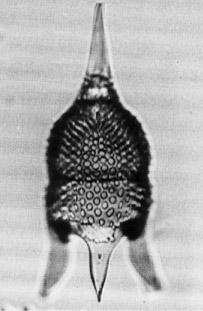 Thyrsocyrtis
(Thyrsocyrtis) hirsuta (Krasheninnikov)
Thyrsocyrtis
(Thyrsocyrtis) hirsuta (Krasheninnikov) Thyrsocyrtis
(Thyrsocyrtis) hirsuta (Krasheninnikov)
Thyrsocyrtis
(Thyrsocyrtis) hirsuta (Krasheninnikov)Podocyrtis
hirsutus Krasheninnikov, 1960, p.300, pl.3, fig.16
Thyrsocyrtis (Thyrsocyrtis)
hirsuta (Krasheninnikov), Sanfilippo and Riedel, 1982, p.173, pl.1,
figs.3-4 (with synonymy)
Subcylindrical form. Hemispherical to subspherical cephalis, poreless or with a few small pores, bearing cylindro-conical horn of extremely variable length (from shorter than cephalis to as long as entire shell). Thorax campanulate, of approximately same width as abdomen or slightly narrower, with circular, close-packed pores. Lumbar stricture distinct. Abdomen subcylindrical to slightly inflated, with pores equal to or slightly larger than those of thorax. Feet tapering from peristome, often as long as abdomen, usually slightly curved with convexity inward, tapered terminally and typically thickened medially. Shell surface slightly thorny (Sanfilippo and Riedel, 1982).
Based on 20 specimens. Length excluding horn 120-220 µm, of cephalothorax 65-95 µm, of abdomen 35-70 µm. Maximum breadth 75-140 µm (Sanfilippo and Riedel, 1982).
T. hirsuta differs from T. tarsipes in lacking perforations on the feet, from T. rhizodon in the feet not being thorned or divided terminally, from T. tensa in having smaller abdominal pores, and from T. robusta in the less rough thorax, less pronounced lumbar stricture and smaller size (Sanfilippo et al., 1985).
The cylindro-conical horn is extremely variable in length, from shorter than the cephalis to as long as the entire shell. The thorax is campanulate to somewhat inflated, and the subcylindrical to slightly inflated abdomen is of approximately the same length and breadth as the thorax. The pores of the abdomen are 1.0-1.5 times as large as those of the thorax (Sanfilippo et al., 1985).
T. hirsuta is found in tropical localities of early to early middle Eocene age. Its morphotypic first appearance is approximately synchronous with the lower limit of the Buryella clinata Zone. Its morphotypic last appearance lies within the Thyrsocyrtis triacantha Zone.
T. hirsuta evolved from T. tarsipes or from an ancestor common to both, and gave rise to T. tensa.